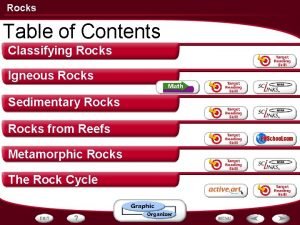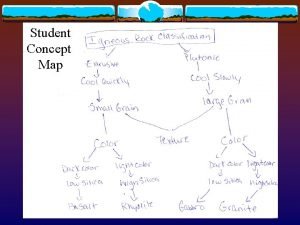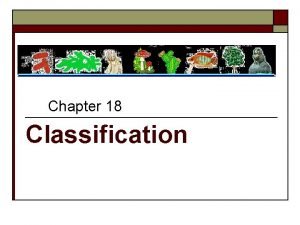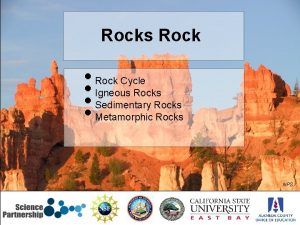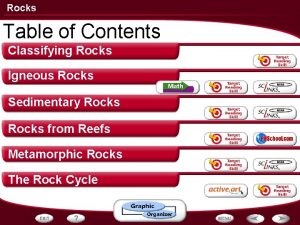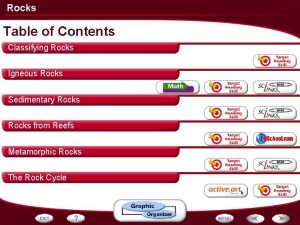Classifying Rocks P 74 77 Rocks 1 Rock















- Slides: 15

Classifying Rocks P 74 -77

Rocks 1. Rock – a mixture of one or more minerals. Example: Granite – a rock made of the minerals quartz, feldspar, mica, and hornblende.

Rocks are classified according to 3 things: 1) Color 2) Texture 3) Mineral Composition

Color Like with minerals, color alone doesn’t give enough information to identify a rock.

Texture 1) Very useful in identifying a rock. 2) Texture is the size, shape, and pattern of a rock’s grains.

3) Grains – the minerals (or other rocks) that make up a rock and give it its texture. 4) Texture describes how the surface of something feels (rough, smooth, grainy, gritty, coarse, oily, silky, bumpy, waxy, chalky).

Grains 1) Grain Size • coarse grain rock = grains are large/easy to see (Ex - diorite) • fine grain rock = grains are so small they can only be seen under a microscope (Ex - slate)

Grains (Continued) 2) Grain Shape – can be smooth and rounded (like conglomerate rock) or jagged (like breccia)

Grains (Continued) 3) Grain Pattern – the way the grains lie in the rock. - can be flat layers (like a stack of pancakes – Ex – Gneiss) or a wavy, swirling pattern (Ex – quartz)

Grains (Continued) 4) No Visible Grains - When some rocks form (flint and obsidian) they cool off so fast that they have a shiny texture like glass.

Mineral Composition Geologists determine the minerals that make up the rock. - They look at the crystal shape - Acid test tells whether the rock contains carbonates - Magnet test tells whether the rock contains iron or nickel

Origin 3 Major Groups of Rocks: Igneous Sedimentary Metamorphic These terms refer to how the rocks in each group formed.

Igneous Rock Formed by cooling of molten rock – magma below the surface or lava at the surface.

Sedimentary Rock Formed when particles of other rock or remains of plants and animals are pressed and cemented together.

Metamorphic Rock Formed when an existing rock is changed by heat, pressure, or chemical reactions. Form deep underground.
 Sedimentary igneous and metamorphic
Sedimentary igneous and metamorphic Igneous rocks metamorphic rocks and sedimentary rocks
Igneous rocks metamorphic rocks and sedimentary rocks How to classify rocks
How to classify rocks Classifying rocks
Classifying rocks Classifying rocks
Classifying rocks Where are igneous rock found
Where are igneous rock found Rock climb
Rock climb A rock climber's shoe loosens a rock and her climbing buddy
A rock climber's shoe loosens a rock and her climbing buddy A rock climber's shoe loosens a rock and her climbing buddy
A rock climber's shoe loosens a rock and her climbing buddy Rock cycle sedimentary
Rock cycle sedimentary Concept map of sedimentary rocks
Concept map of sedimentary rocks Concept map of rock types
Concept map of rock types Volcanic rocks and plutonic rocks
Volcanic rocks and plutonic rocks Extrusive rock
Extrusive rock Effect of transactions on accounting equation examples
Effect of transactions on accounting equation examples Finding order in diversity
Finding order in diversity



